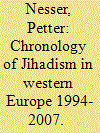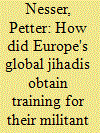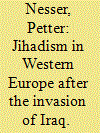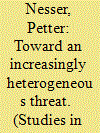|
|
|
Sort Order |
|
|
|
Items / Page
|
|
|
|
|
|
|
| Srl | Item |
| 1 |
ID:
084628


|
|
|
|
|
| Publication |
2008.
|
| Summary/Abstract |
Considering Europe's long history of terrorist violence by separatist, leftist and rightwing groups, terrorism by militant Sunni Islamists has until recently been a marginal phenomenon. However, empirical data presented in this chronology suggests it constitutes a growing and increasingly lethal threat, and a worrisome trend in the context of increased tensions between the Muslim world and the West in the wake of 9/11 and the U.S.-led invasions of Afghanistan and Iraq, which needs to be dealt with on many levels-socially, politically, and economically. The current chronology is meant to serve as a tool for conducting academic research on the scope of the threat, and for mapping incidents that might be surveyed in more depth to create a better understanding of its organizational, operational, and motivational patterns.
|
|
|
|
|
|
|
|
|
|
|
|
|
|
|
|
| 2 |
ID:
081502


|
|
|
|
|
| Publication |
2008.
|
| Summary/Abstract |
This article examines, compares, and contrasts the ways in which "global jihadis" have trained for terrorism in Western Europe. Before the invasion of Afghanistan, the terrorists received training in Al Qaeda paramilitary camps. After invasion, they had to find alternative training methods and arenas. It is widely assumed that the Internet has taken over the role of the Afghan camps. The current survey suggests that the Internet's role as a "virtual training camp" might be overstated. Although the Net has become an important tool for terrorists on many levels, they maintain an urge to obtain real-life, military-style training in jihadi combat zones. Despite difficulties and risks, many of today's terrorists attend terrorist training facilities in Pakistan or other places. The main characteristic of training practices after the invasion of Afghanistan seems to be that, from an organizational perspective, the push for training and preparation comes from "below" rather than from "above
|
|
|
|
|
|
|
|
|
|
|
|
|
|
|
|
| 3 |
ID:
103792


|
|
|
|
|
| Publication |
2011.
|
| Summary/Abstract |
The article explores ideological fault lines among Sunni Muslim militants (jihadists) in Europe since the mid-1990s. It argues there have been disputes among the militants about whether to prioritize local struggles or Al Qaeda's global war, and about the legitimacy of launching terrorist attacks in European states offering political asylum to Muslims. It concludes that Europe's militants have become more ideologically unified in conjunction with the invasions of Afghanistan, Iraq, and the Mohammed drawings, seeing European countries as legitimate and prioritized targets, and identifying with Al Qaeda.
|
|
|
|
|
|
|
|
|
|
|
|
|
|
|
|
| 4 |
ID:
071257


|
|
|
|
|
| Publication |
2006.
|
| Summary/Abstract |
This article investigates the importance of the invasion and occupation of Iraq as motivation for recent acts of jihadist terrorism in Western Europe. It analyses the mass casualty terrorist attack attributed to a group of Islamist militants in Madrid on 11 March 2004, and the killing of a Dutch filmmaker on the streets of Amsterdam by an Al Qaeda-inspired terrorist network. The first case has been assumed to be mainly motivated by the Iraq war, whereas the other case has been perceived as an act by an individual, motivated by domestic factors in Holland. The article situates these acts of terrorism within the theory of so-called spillover effects from armed conflicts to international terrorism. It argues that the Iraq war was a significant motivational factor for the terrorists in both cases, but that the terrorists linked the Iraq issue with perceived injustices against Muslims in Europe and globally.
|
|
|
|
|
|
|
|
|
|
|
|
|
|
|
|
| 5 |
ID:
132186


|
|
|
|
|
| Publication |
2014.
|
| Summary/Abstract |
The 2012 Toulouse and Montauban shootings and the grisly murder of Drummer Lee Rigby in Woolwich in 2013 are stark reminders of a continued terrorist threat posed by jihadist terrorists in Europe. Whereas the 2011 death of Osama bin Laden and the advent of the "Arab Spring" fed expectations that international jihadism was a spent force, attack activity in Europe does not only seem to persist, but as will be shown here, the region has actually faced an increase in terrorist plots over the past few years.
|
|
|
|
|
|
|
|
|
|
|
|
|
|
|
|
| 6 |
ID:
178981


|
|
|
|
|
| Summary/Abstract |
How can vulnerable states adjacent to countries embroiled in civil war avoid conflict contagion? Jordan has all the classic attributes highlighted in the literature as creating vulnerabilities susceptible to spillover. It adjoins Syria and Iraq where jihadists have operated freely. It has a weak economy, refugees pouring in from adjacent conflicts and is home to hundreds—if not thousands—of jihadists. Moreover, jihadists consider the Jordanian regime to be traitors—who conspire with the enemies of Islam—and they want to replace it with an Islamic state. However, as we show, very few jihadist attacks have happened in Jordan. We test three hypotheses for the limited spillover. Our analysis suggests a state policy that we dub “calibrated repression” is the most significant explanation. This means that Jordan protects against spillover by repressing jihadist attempts at infiltrating the kingdom and clamping down on local terrorist cells linked to the Islamic State while keeping other domestic jihadist elements in check through co-optation. The regime restrains the use of force against less acute threats and displays some leniency towards radicals when the situation allows. Our findings speak to the broader literature on spillover and offer insights into the understudied topic of mechanisms limiting spillover in high-risk environments.
|
|
|
|
|
|
|
|
|
|
|
|
|
|
|
|
|
|
|
|
|